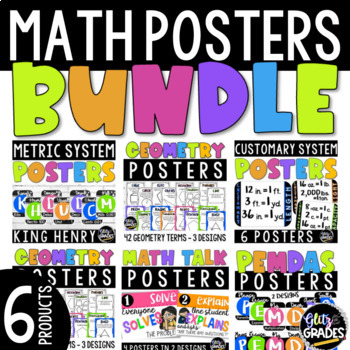5th Grade Math Posters Geometry and Measurement Posters BUNDLE
- Zip
What educators are saying
Products in this Bundle (5)
Description
This bundle includes 5 separate math resources that are perfect for your Geometry and Measurement units for upper elementary and middle school students! Do your students struggle to remember measurement conversions, types of triangles, or the names of certain polygons? Look no further!
The FIVE products included are:
- GEOMETRY POSTERS - 3 Sets of Posters (Neon Colors, Glitter, or Wood Grain background) including the following 42 geometry terms and definitions:
- Solid Objects: Prism, Pyramid, Cube, Cylinder, Cone, Sphere
- Circles: Diameter, Radius, Circumference, Circle
- Quadrilaterals: Kite, Trapezoid, Rhombus, Parallelogram, Rectangle, Square,
- Triangles: Scalene, Isosceles, Equilateral, Acute, Obtuse, Right
- Polygons: Octagon, Heptagon, Hexagon, Pentagon, Quadrilateral, Polygon
- Angles: Acute, Obtuse, Right
- Lines: Perpendicular, Intersecting, Parallel, Line Segment, Ray, Line
- Shape/Objects: Base, Edge, Face, Vertex, Side
- PEMDAS ORDER OF OPERATIONS POSTERS
- 2 Sets of Posters including the Order of Operations mnemonic PEMDAS (Please Excuse My Dear Aunt Sally).
- CUSTOMARY SYSTEM POSTERS
- These bright, colorful posters and perfect for measurement units in upper elementary and beyond. The set includes posters of the following customary units:
- Length: 12 in = 1 ft; 3 ft = 1 yd; 36 in = 1 yd; 5,280 ft = 1 mi; 1760 yd = 1 mi
- Capacity: 8 oz = 1 c; 2 c = 1 pt; 16 oz = 1 pt; 32 oz = 1 qt; 2 pts. = 1 qt; 4 c = 1 qt; 4 qts = 1 gal; 16 c = 1 gal; 8 pts = 1 gal
- Weight: 16 oz = 1 lb; 2,000 lbs = 1 ton; 32,000 oz = 1 ton
- These bright, colorful posters and perfect for measurement units in upper elementary and beyond. The set includes posters of the following customary units:
- METRIC SYSTEM POSTERS
- 2 Sets of Posters including the following metric system prefixes and a mnemonic saying to help your students remember the order while converting units.
- Kilo, Hecto, Deka, Unit, Deci, Centi, Milli
- (King Henry Doesn't Usually Drink Chocolate Milk)
- 2 Sets of Posters including the following metric system prefixes and a mnemonic saying to help your students remember the order while converting units.
- MATH TALK POSTERS
- Included in this resource is a set of two different colored Math Talk posters. Posters include Math Talk steps Solve, Explain, Question and Justify. Use these in your classroom for your Math Talk discussions!
Did you know you can earn FREE TPT money?
Earn free TPT credits by reviewing your purchases! Each time you leave a review for a product that you purchased, you earn credits to use toward your next purchase.
Let's Connect!
I'd love to connect with you!
Follow me on TPT to get updates when new products are posted!
I love seeing products in action! Feel free to tag @glitzandgrades in any Instagram posts where you are putting @glitzandgrades products to use.
Thank you so much for your interest in Glitz and Grades teaching products.





